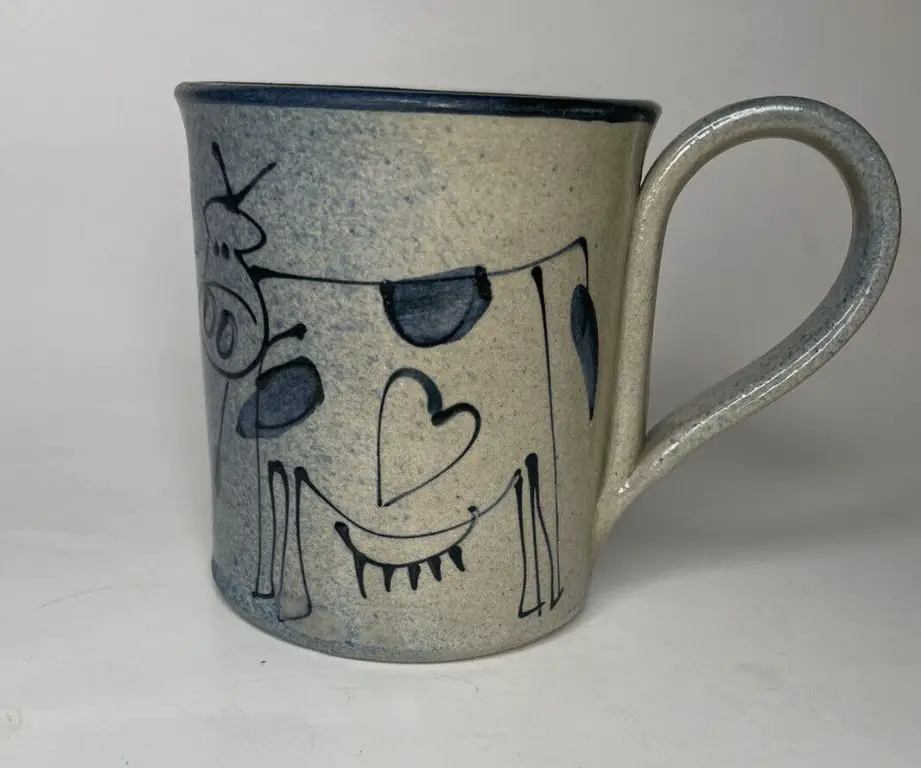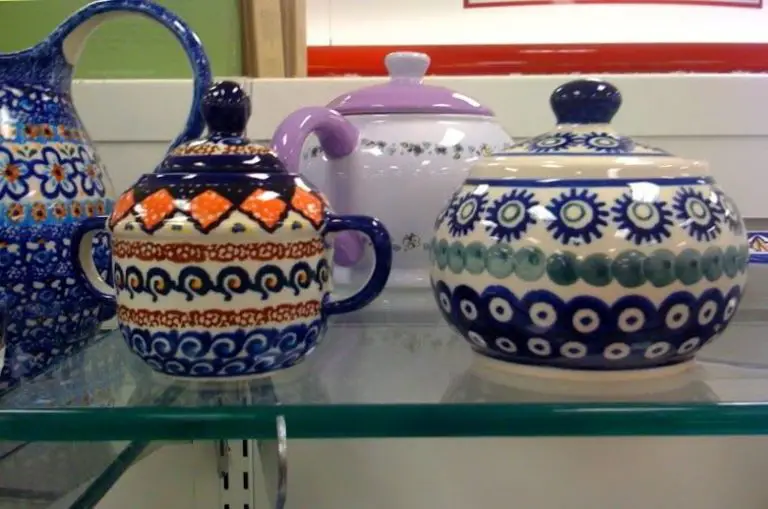What Are The Different Types Of Ceramic Ware?
Ceramic ware refers to objects made from clay that have been hardened by high heat. The word “ceramic” comes from the Greek word keramos, meaning potter’s clay. Humans have been making ceramic objects for thousands of years. Archaeological evidence shows that pottery was being made as early as 20,000 BC in China and that ceramic figurines and sculptures were being produced across Eurasia by 24,000 BC, according to the Brief history of ceramics and glass on the American Ceramic Society website https://ceramics.org/about/what-are-engineered-ceramics-and-glass/brief-history-of-ceramics-and-glass/. Ceramics were initially made for utilitarian purposes like storing food and water, but then developed into decorative and artistic objects over time.
Earthenware
Earthenware is pottery made from clay that is fired at lower temperatures, typically between 1,800-2,000°F. It is opaque and porous. Some examples of earthenware pottery include terracotta and clay flower pots. Earthenware is more delicate and brittle than other ceramics because of the lower firing temperatures. https://en.wikipedia.org/wiki/Earthenware
Because earthenware is porous, it can soak up liquids and moisture. This makes it unsuitable for uses like tableware or vessels for food storage. However, the absorbency makes earthenware excellent for flower pots and planters. Some of the most common types of earthenware pottery are terracotta pots and clay pots used in gardening. https://mitticool.com/types-of-earthenware-for-home/
Stoneware
Stoneware is a type of ceramic made from clay that is fired at high temperatures between 2,100 and 2,300 degrees Fahrenheit. At these high temperatures, the clay vitrifies, becoming nonporous and durable. This makes stoneware excellent for functional items like crockery and food storage containers as it does not absorb liquid or bacteria.
Stoneware clay has more flux materials than earthenware but less than porcelain, giving it a more vitreous body when fired. It remains permeable to air and water even when fired unless glazed. Common glazes for stoneware include salt glaze, in which sodium chloride is introduced to the kiln towards the end of the firing process. The sodium vapor adheres to the clay, forming a glossy glaze. Colored glazes using metal oxides are also frequently used on stoneware.
Some examples of popular stoneware items include mugs, crocks, jugs, vases, and casserole dishes. The semi-vitreous and nonporous nature of stoneware makes it an excellent material for cooking, storing, and serving food, as it is durable and resistant to scratches, stains, odors and bacteria. Famous American stoneware makers include the Jugtown Pottery in North Carolina and the Pewabic Pottery in Michigan.
Porcelain
Porcelain is a translucent ceramic made from kaolin clay that is fired at very high temperatures between 2,200° and 2,600°F, making it non-porous and hard. According to the Made How article How porcelain is made, porcelain is made from a mixture of minerals including kaolin, quartz, and feldspar that vitrify and become glass-like when fired at high temperatures.
Porcelain was first made in China over a thousand years ago and was known as ‘china’ in Europe, hence the name for porcelain tableware and figurines. Some examples of porcelain ware are fine china dinnerware and intricate decorative figurines. The non-porous, glossy surface of porcelain makes it ideal for kitchenware and tableware. It has high durability and heat resistance. Due to its elegance and delicate look, porcelain has been widely used throughout history for decorative items like vases, statues, tiles, and jewelry beads. The translucent white color and fragile, glass-like texture of porcelain has made it a popular choice for fine dishes and luxury housewares.
Bone China
Bone china is a type of porcelain that is composed of clay, feldspar, and at least 25% bone ash.[1] The addition of bone ash gives bone china a very fine texture and a milky-white, translucent appearance. It was first developed in England in the late 18th century by Josiah Spode.[2] Some examples of bone china include fine china dinnerware from manufacturers like Wedgwood, Royal Albert, and Royal Crown Derby.
Bone china is known for being extremely thin, lightweight and delicate. It has high translucency similar to porcelain, but its warm undertones differentiate it from porcelain’s brighter white color.[3] The high percentage of bone ash enables the pieces to be fired at very high temperatures, contributing to their delicate, refined quality.
[1] https://www.wedgwood.com/en-us/welcome-to-wedgwood/buying-guides/a-guide-to-bone-china
[2] https://www.williamedwardshome.co.uk/blog/so-what-is-the-difference-between-fine-bone-china-bone-china-and-porcelain-en/
[3] https://www.harrisscarfe.com.au/hub/home/bone-china-vs-fine-china-vs-porcelain
Terra Cotta
Terra cotta is a type of unglazed porous earthenware, commonly used to make items like flower pots and architectural decorations. The clay is typically red or brownish-orange in color after firing. Terra cotta has been used across many cultures for thousands of years, dating back to ancient China, Greece, and Rome. Some of its key properties and uses include:
Unglazed and porous – Terra cotta is fired at lower temperatures and not given an impervious glaze coating. This makes it breathable but also requires sealing for some outdoor uses.
Durable and weather resistant – While porous, terra cotta is durable and can stand up to exposure to sun, rain, and freezing temperatures. It’s commonly used for outdoor planters and other garden decor.
Natural red/orange coloring – The natural red-orange terra cotta clay maintains its earthy colors after firing without any additional glazes or pigments needed.
Sculpting and decorative uses – The versatility of terra cotta clay allows artisans to hand build or throw functional and decorative objects with fine detail.
Some common modern uses of terra cotta include flower pots, garden ornaments, architectural decorations like roof tiles or chimney pots, oil burners, and various sculptural wares.
Stoneware Glazes
Stoneware glazes are formulated to mature and become glasslike at high stoneware temperatures between 2200°F and 2400°F. Common stoneware glazes include salt glaze, slip glaze, ash glaze, and alkaline glaze.

Salt glazing involves introducing common salt into the kiln near the end of the firing process. The sodium from the salt reacts with silica in the clay body to form a glassy coating of sodium silicate on the surface. Salt glazed stoneware has a distinctive orange peel texture.
Slip glazing involves applying a mixture of clay and water called a slip to the piece before firing. The slip vitrifies in the kiln and creates a smooth, glossy surface. Multiple layers of contrasting colored slips can be used to create patterns.
Ash glazes utilize wood ash, which is rich in potash, mixed with clay and water. Ash glazes produce matte surfaces with a subtle mottled effect. The high alkaline content of the ash flux reacts with the clay to form the glassy coating.
Alkaline glazes are high in alkaline oxides like sodium and potassium, which act as fluxes to lower the melting temperature of the glaze. They produce semi-matte surfaces and are commonly used for stoneware.
Some other popular stoneware glazing techniques include feathering, dripping, pouring, and spraying layers of contrasting colored glazes.
Source: https://diamondcoretools.com/blogs/resources/pottery-glazing-techniques
Porcelain Glazes
Porcelain can be glazed using a variety of techniques to achieve different decorative effects. Some common glazing techniques for porcelain include:
Underglaze – An underglaze is applied directly to unfired porcelain and then covered with a transparent overglaze after firing. Underglazes allow for intricate hand-painted designs. (Source: https://diamondcoretools.com/blogs/resources/pottery-glazing-techniques)
Overglaze – An overglaze is a glaze applied on top of an already fired and glazed piece of porcelain. Overglazes create decorative effects like colors and patterns over the base glaze. Overglazes can be brushed, sponged, or sprayed onto the ware. (Source: https://www.thecrucible.org/guides/ceramics/how-to-glaze/)
Majolica Glaze – A Majolica glaze has an opaque, matte look and is traditionally used in Italian earthenware. Majolica glazes create colorful, decorative surfaces on porcelain. The glaze is applied with a brush.
Graffito – Graffito is an incised decoration made by scratching through a glaze to reveal the porcelain or underglaze below. It creates thin white lines on colored glazes.
Mishima – In the Mishima technique, an underglaze is brushed onto porcelain. A design is hand-carved through the underglaze to reveal the white porcelain below. Clear glaze is then applied on top.
Decorative Techniques
There are many ways to decorate ceramic ware to make it more aesthetically pleasing. Some of the most common decorative techniques include:
Hand-painting: One of the oldest decoration methods, where pigments are applied by hand using brushes, sponges, or other tools. Popular techniques include maiolica, Delftware, and freehand brushwork. Ceramic Decorating Techniques
Transfer-printing: Involves engraving a design into a copper plate, then transferring the design onto tissue paper, and finally transferring it to the ceramic surface. This allows for mass production of detailed decorative designs. Blue and white transferware is very common.
Gilding: Applying thin sheets of metal, like gold leaf or platinum, over a ceramic surface to create a shiny, metallic look. Gold gilding has been used since ancient times to create luxurious wares.
Mishima/Inlay: involves sculpting or carving the clay surface and then filling the recesses with colored slips or clays to create patterned effects. The contrast creates a graphic, eye-catching look.
Sgraffito: Similar to mishima but done on colored or slipped surfaces by scratching through a layer to reveal the contrasting color underneath. Intricate linear designs can be achieved.
Stenciling: Applying paint over stencils to quickly and accurately create repeated imagery on ceramic surfaces. From simple patterns to complex scenes, a variety of looks can be achieved.
Luster: Metallic compounds like silver, copper, or gold are applied over glazed surfaces and fired at a low temperature to create an iridescent, pearlescent sheen. This technique has been used since ancient Islamic times.
With so many options available, ceramic artists have great freedom to creatively decorate their work and produce visually stunning results.
Conclusion
Ceramic wares encompass a diverse range of pottery, from basic earthenware to delicate porcelain. Each type has unique properties that affect their uses. Earthenware is porous and durable – ideal for flowerpots and dishes. Stoneware is non-porous and withstands high temperatures – perfect for ovenware. Porcelain is highly refined and translucent – valued for its beauty in tableware and art. Bone china adds bone ash to create an extremely white and delicate material used in fine teaware. Terra cotta consists of natural clay hardened in the sun, traditionally used in sculpture and roof tiles. Glazes provide an impermeable decorative coating, with colorful stoneware glazes contrasting with translucent porcelain glazes. Decorative techniques like hand-painting and etching allow artisans to embellish ceramic pieces. With such a diversity of ceramic types, artisans can choose the optimal material for their creative vision and practical use.





